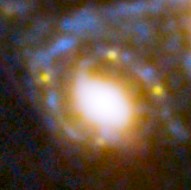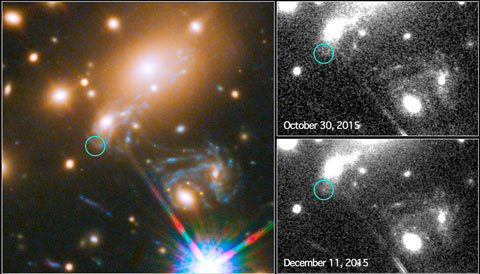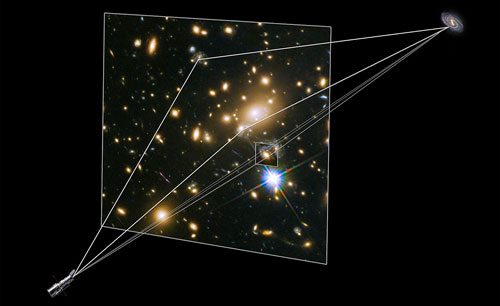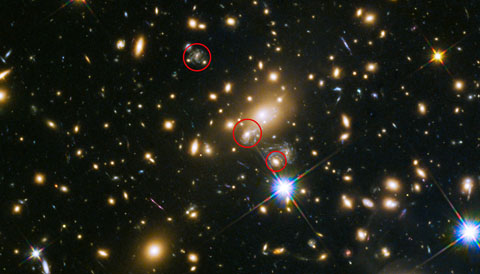
NASA / ESA / S. Rodney & FrontierSN /T. Treu / P. Kelly & GLASS / J. Lotz & Frontier Fields / M. Postman & CLASH / Z. Levay
Several months ago, we wrote about the discovery of Supernova Refsdal, an exploding star in a faraway galaxy, whose light had split into four images on its way to Earth.
Now astronomers have used the Hubble Space Telescope to spot the supernova — again! On December 11th, Patrick Kelly (University of California, Berkeley) and colleagues spotted a fifth image of the exact same explosion, more than a year after Hubble caught the previous four images.
The time travel trick occurs by way of gravitational lensing. The gravity of a massive object magnifies light sources in just the right place behind it and may distort or split their images.
In the case of Supernova Refsdal, the light traveled toward Earth for more than 9 billion years. On its way here, it passed near a massive elliptical galaxy. Though a perfectly spherical galaxy would have created a ring, the oval-shaped galaxy instead created an Einstein’s Cross, splitting the supernova’s light into four images around the lensing galaxy.

NASA / ESA / P. Kelly
The cross images were the first four that Hubble captured in November 2014. But the galaxy is part of a larger cluster called MACS J1149.5+2223, one of the six lucky clusters getting lots of Hubble attention thanks to the Frontier Fields project. The cluster’s gravity — that is, not just its stars in galaxies but also its hot intergalactic gas, as well as its dark matter — created additional images.
A flurry of computer simulations published immediately after the supernova’s discovery showed that there was probably one supernova image we missed in 1998. And they all predicted that another image would be found within one to several years of the 2014 discovery. Though the models weren’t spot on in predicting the exact time and location of the fifth image, they all came close.
The new image’s brightness is still increasing, and Kelly’s team plans to wait until it begins to fade before analyzing the data further.

NASA / ESA
The supernova was named in honor of Norwegian astronomer Sjur Refsdal, who, half a century before, had predicted that astronomers would one day spot such a supernova caught in a gravitational lens. The supernova will help shed light on the foreground galaxy cluster’s mass distribution. The cluster’s effect on the supernova’s light is too complex to use its five images to test theories about the universe’s expansion, as Refsdal had optimistically predicted could be done.
Read more about this fascinating object and all its various apparitions in the ESA/Hubble science releases of the appearance of the first four images and the discovery of a fifth image.

NASA / ESA / S. Rodney & FrontierSN / T. Treu, P. Kelly, & GLASS / J. Lotz & Frontier Fields / M. Postman & CLASH / Z. Levay
 3
3









Comments
Kevin
December 25, 2015 at 10:08 pm
I wonder how many images we capture from Hubble, and ground-based telescopes, are subject to gravitational lensing, especially when you consider the distances involved and the number of galaxies between the light's point of origin and us. It strikes me that it would be rare if light from distant objects missed absolutely everything on its way here. It's analogous to firing a high powered rifle through a billion mile long valley and never hitting a spire or grazing the wall.
You must be logged in to post a comment.
David-Majors
December 26, 2015 at 2:47 am
I noticed the one item missing from the release was the type of supernovae
You must be logged in to post a comment.
Dave-Perks
December 26, 2015 at 11:36 am
Interesting article but very misleading title, they have not predicted a supernova, they have predicted the appearance of an image of a supernova - not really the same thing at all.
You must be logged in to post a comment.
You must be logged in to post a comment.